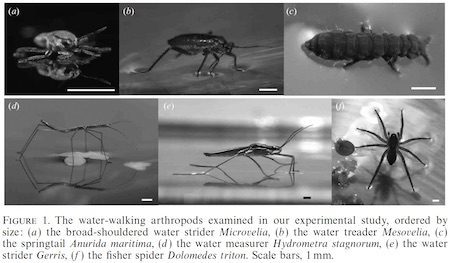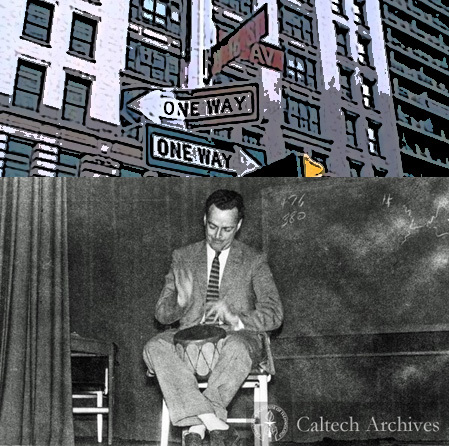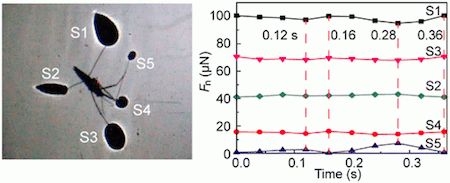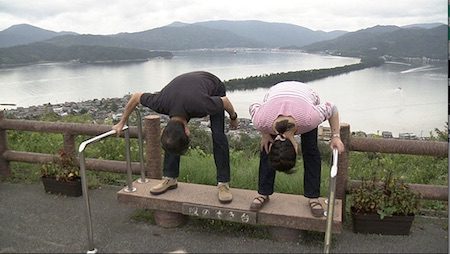Marc Abrahams's Blog, page 244
October 20, 2016
Eleni Pinnow joins The Luxuriant Flowing, Former, or Facial Hair Club for Social Scientists (LFFFHCfSS)
Eleni Pinnow has joined The Luxuriant Flowing, Former, or Facial Hair Club for Social Scientists (LFFFHCfSS). She says:
This is a picture of me kissing a redwood tree. I am a Cognitive Psychologist and I study how people process spoken language; mostly, though, I mentor undergraduate research and try to instill the job of the scientific process in my students. I started growing my hair out after tenure because I needed a new challenge. I love my long untamed hair (several students remarked on its similarity to Ms. Frizzle from the Magic School bus).
Eleni Pinnow, Ph.D, LFFFHCfSS
Associate Professor, Psychology
University of Wisconsin, Superior
Superior, Wisconsin, USA


Shadows Cast by Spider Legs, Used in Physics Calculations
Anticipating Halloween, the American Chemical Society has published a study about using the shadows cast by spider legs, for scientific purposes. The paper is:
“Elegant Shadow Making Tiny Force Visible for Water-Walking Arthropods and Updated Archimedes’ Principle,” Yelong Zheng, Hongyu Lu, Wei Yin, Dashuai Tao, Lichun Shi, and Yu Tian, Langmuir, 2016, 32 (41), pp. 10522–10528. The authors, at Tsinghua University, China, report:
“Forces acted on legs of water-walking arthropods with weights in dynes are of great interest for entomologist, physicists, and engineers. While their floating mechanism has been recognized, the in vivo leg forces stationary have not yet been simultaneously achieved. In this study, their elegant bright-edged leg shadows are used to make the tiny forces visible and measurable based on the updated Archimedes’ principle. The force was approximately proportional to the shadow area with a resolution from nanonewton to piconewton/pixel. The sum of leg forces agreed well with the body weight measured with an accurate electronic balance, which verified updated Archimedes’ principle at the arthropod level”
(Thanks to Tony Tweedale for bringing this to our attention.)
BONUS: An earlier study that used shadow calculation: the MIT study “The hydrodynamics of water-walking arthropods“, by Ig Nobel Prize winner David Hu, and John Bush. Here’s a bit of detail from that study:


The Neural Bases of Disgust for Cheese: An fMRI Study
Brain researchers, using advanced fMRI technology, made another unexpected advance toward understanding how the brain does or does not work. Their newly published study is:
“The Neural Bases of Disgust for Cheese: An fMRI Study,” Jean-Pierre Royet, David Meunier, Nicolas Torquet, Anne-Marie Mouly and Tao Jiang, Frontiers in Human Neuroscience, vol. 10, October 2016, article 511. The authors, at Lyon Neuroscience Research Center, Sorbonne Universités, Université Pierre et Marie Curie, Institut de Biologie Paris Seine, and CNRS, Neuroscience Paris Seine, Paris, France, explain:
“In this study, we show that a higher percentage of people are disgusted by cheese than by other types of food. Functional magnetic resonance imaging then reveals that the internal and external globus pallidus and the substantia nigra belonging to the basal ganglia are more activated in participants who dislike or diswant to eat cheese (Anti) than in other participants who like to eat cheese, as revealed following stimulation with cheese odors and pictures.”
Here are further details from the study:
(Thanks to Neil Martin for bringing this to our attention.)

October 19, 2016
A shortest-possible walking tour through the pubs of the UK
A shortest-possible walking tour through the pubs of the United Kingdom — that’s an advanced form of the mathematicians’ favorite, The Traveling Salesman Problem. William Cook and colleagues at the University of Waterloo tackled this nastily complex problem:
Nearly everyone in the UK knows by heart the best path to take them over to their favorite public house. But what about jotting down the shortest route to visit every pub in the country and return home safely? That is what we set out to do….
Using geographic coordinates of 24,727 pubs provided by Pubs Galore and measuring the distance between any two pubs as the length of the route produced by Google Maps, what is the shortest possible tour that visits all 24,727 and returns to the starting point? …
This is the problem we have solved. The optimal tour has length 45,495,239 meters. To be clear, our main result is that there simply does not exist any pub tour that is even one meter shorter (measuring the length using the distances we obtained from Google) than the one produced by our computation. It is the solution to a 24,727-city traveling salesman problem (TSP).
The UK Pubs tour is easily the largest such road-distance TSP that has been solved to date, having over 100 times more stops than any road-distance example solved previously by other research groups.
Here’s one low-resolution sliver of what is a much more detailed map of the tour:
(Thanks to Mason Porter for bringing this to our attention.)
BONUS: William Cook’s book on the history of the Traveling Salesman Problem.

Nominative determinism: Dr. Waschbusch, gynecologist
An anonymous patient sends this example of nominative determinism:
 “Gynecologist Laure J. Waschbusch (pronounced ‘wash bush’) has a practice near St. Paul / Minneapolis, Minnesota, in the U.S.”
“Gynecologist Laure J. Waschbusch (pronounced ‘wash bush’) has a practice near St. Paul / Minneapolis, Minnesota, in the U.S.”

Podcast 86: Walking on feet in the city (accompanied by a bongo drum)
A scholarly study about the rhythm, rhythm, rhythm of walking, walking, walking in the city. That’s what you’ll hear about — and you’ll hear it accompanied by a bongo drum — in this week’s Improbable Research podcast.
SUBSCRIBE on Play.it, iTunes, or Spotify to get a new episode every week, free.
This week, Marc Abrahams discusses a study about the rhythms of walking in cities, with fluid dynamicist Nicole Sharp, creator of FYFD, the internet’s most popular site about fluid dynamics. Sharp accompanies her dramatic readings from the study, here, with a bongo drum.
Walking in the city: “Walking and rhythmicity: Sensing urban space,” by Filipa Matos Wunderlich, published in the Journal of Urban Design, in 2008.
Bongo drums .
Here, inspired by the Wunderlich study, is an artistic composite image, created by Nan Swift starting with a photo from the Caltech archives, of city streets and bongo-playing physicist Richard Feynman, who is known to have walked many city streets:

The mysterious John Schedler or the shadowy Bruce Petschek perhaps did the sound engineering this week.
The Improbable Research podcast is all about research that makes people LAUGH, then THINK — real research, about anything and everything, from everywhere —research that may be good or bad, important or trivial, valuable or worthless. CBS distributes it, on the CBS Play.it web site, and on iTunes and Spotify).

October 18, 2016
When are World Standards Day in 2016?
This year, 2016, World Standards Day was on Friday, October 14. One of the competing official announcements says:
Each year on 14 October, the members of the IEC, ISO and ITU celebrate World Standards Day, which is a means of paying tribute to the collaborative efforts of the thousands of experts worldwide who develop the voluntary technical agreements that are published as international standards.
 This year the United States is celebrating World Standards Day on Thursday, October 27.
This year the United States is celebrating World Standards Day on Thursday, October 27.
The U.S. celebration trumpets the year’s international official theme: “Standards Build Trust”. There will be a gala dinner in Washington, D.C., on World Standards Day, to celebrate the day and the theme.
Last year, 2015, World Standards Day was on October 14. The United States celebrated the 2015 World Standards Day on September 28-October 2.

A journal for the confused or would-be-confused
 If you are confused by academic journals, or want to be confused by academic journals, do not miss Integrated Journal of British.
If you are confused by academic journals, or want to be confused by academic journals, do not miss Integrated Journal of British.
This, in its own words, is what the Integrated Journal of British is all about: “The journal addresses the issues for the vertical and horizontal applications in their respective areas.”
[UPDATE October 18, 2016: The journal’s web site seems to have vanished. Indirect traces remain elsewhere, as in this listing in a directory of scholarly journals.]
This song, as sung by mezzo-soprano Sarah Connolly, exemplifies the spirit that perhaps animates readers of the journal:
For a very different use of that same tune, see the concluding act of “The Jargon Opera”, which had its debut as part of the 2002 Ig Nobel Prize ceremony.

October 17, 2016
How to ‘cheat’ at sport without really ‘cheating’ – part 1: Praying
“Ajax, through Athena’s spite, slipped upon some offal that was lying there from the cattle which Achilles had slaughtered in honor of Patroklos, and his mouth and nostrils were all filled with cow dung.”
 The account above is from The Iliad – in which Homer relates how Odysseus prays to the goddess Athena to request that Ajax [pictured, dejected *] loses a racing competition. Since then, many have asked whether it’s ethically justifiable to ‘pray to win’ at sports – even irrespective of whether it works or not. Some say that simply having an ‘intent to cheat’ is in-itself unsporting. Prof Anthony J. Kreider, for example (Miami Dade College, US) explains his viewpoint in a paper for the Journal of the Philosophy of Sport :
The account above is from The Iliad – in which Homer relates how Odysseus prays to the goddess Athena to request that Ajax [pictured, dejected *] loses a racing competition. Since then, many have asked whether it’s ethically justifiable to ‘pray to win’ at sports – even irrespective of whether it works or not. Some say that simply having an ‘intent to cheat’ is in-itself unsporting. Prof Anthony J. Kreider, for example (Miami Dade College, US) explains his viewpoint in a paper for the Journal of the Philosophy of Sport :
“It can be seen that prayers for assistance are unsporting by examining cases of other, similar kinds of unfair (though non–divine directed) requests for assistance. A cyclist who attempted to gain an advantage over her rival by asking her manager to shoot out the rival’s rear tire with a BB gun would be attempting to cheat. A similar cyclist who suggested that his coach should push him up a steep incline at an unobserved location on the course would be attempting to cheat as well.
Requests for divine assistance differ from these kinds of cases only in the individual of whom the assistance is asked, and this difference is not an important moral difference. Requests for God to help one make it up a hill (say, by God granting one additional strength, or by God causing a stiff breeze to be at one’s back, or whatever) are as much attempts at cheating as the above. Similarly, asking God to intervene in a manner that interferes with one’s opponent’s efforts (say, by causing the lead rider to have a flat tire) is also attempting to cheat.”
See: ‘Prayers for Assistance As Unsporting Behavior ‘in: Journal of the Philosophy of Sport, Volume 30, 2003 – Issue 1. (A full copy in Word™ format [.doc] may be found here)
Note: Improbable wondered if any empirical experiments have been conducted to ascertain whether ‘praying to win’ might work or not – apparently there haven’t – many thanks to professor Kreider for his assistance with information.
* It’s not really Ajax – just an artist’s impression (by Asmus Jakob Carstens) of what he might possibly have looked like had he (or if he) existed.
Coming soon: ‘How to ‘cheat’ at sport without really ‘cheating’ – part 2

October 16, 2016
Upside-down crotch-peeping tourists in Japan
“The observatory crotch peep platform is being installed, a lot of tourists to experience the crotch peeping.” — one highlight from NHK Zero’s TV report about the 2016 Ig Nobel Prize winners.
The image you see here, from the TV program, shows how people have been influenced by the winner of the 2016 Ig Nobel Prize for perception. That prize was awarded to Atsuki Higashiyama and Kohei Adachi, for investigating whether things look different when you bend over and view them between your legs.
They documented their research, in the study “Perceived size and Perceived Distance of Targets Viewed From Between the Legs: Evidence for Proprioceptive Theory” [by Atsuki Higashiyama and Kohei Adachi, published in the journal Vision Research, vol. 46, no. 23, November 2006, pp. 3961–76].

Marc Abrahams's Blog
- Marc Abrahams's profile
- 14 followers







